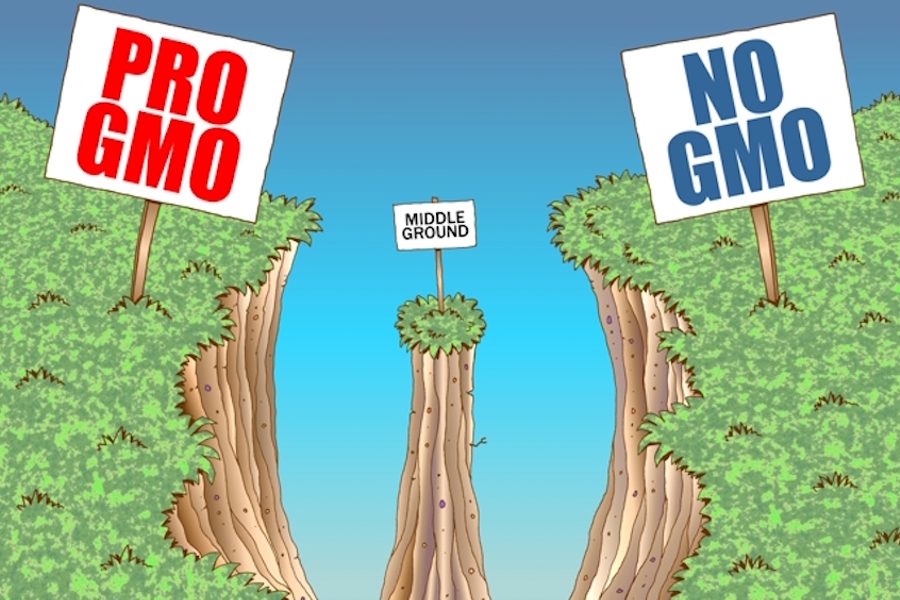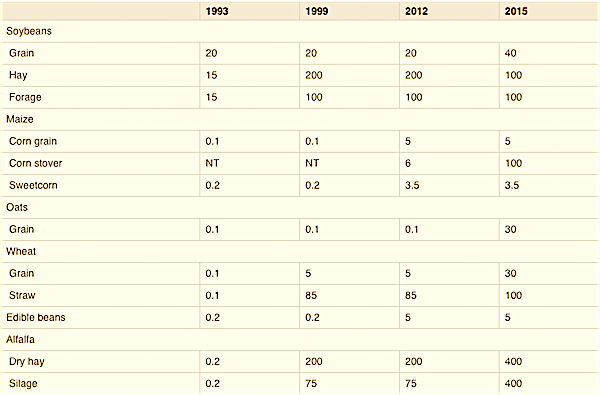Organic Farmers Are Not Anti-Science but Genetic Engineers Often Are
Elizabeth Henderson

At one of the public brainstorming sessions for the New York Organic Action Plan, an organic farmer made an impassioned plea for “independent science” and told us that, with 8.5 billion mouths to feed by 2050, we will need genetic engineering to prevent starvation.
I would like to examine these words carefully to decipher what they mean, how they are being used, and suggest how the movement for locally grown organic food in this country should respond.
What is the meaning of “independent science”? As co-chair of the Policy Committee for the Northeast Organic Farming Association of New York (NOFA-NY), I have been an active participant in the coalition that is campaigning to pass GMO labeling legislation in New York. In this capacity, I have spoken at public meetings, to the press and on radio interviews. The question that I hear from proponents of biotechnology is: “Why do you organic farmers oppose science, like the climate deniers?”
The first time I heard this, I was startled and felt defensive. Had I ever opposed science? I searched back through things I had written and reviewed all the policy resolutions the members of NOFA-NY had passed over the years. I found a few places where I criticized reductionist science and defended “indigenous knowledge” (things like composting and crop rotations, methods that people practice and pass on to their children that have not been proven by research at a university), but nowhere could I find any statement opposing science. Just recently, I reviewed with approval this statement from an organic farming group:
We support the International Federation of Organic Agricultural Movement’s (IFOAM) definition that organic agriculture is a production system that sustains the health of soils, ecosystems and people. It relies on ecological processes, biodiversity and cycles adapted to local conditions, rather than the use of inputs with adverse effects. Organic agriculture combines tradition, innovation and science to benefit the shared environment and promote fair relationships and a good quality of life for all involved.
My farm has cooperated in any number of research projects with Cornell University scientists. We have tested cover crops, held a field day with the Cornell soil health group to allow them to demonstrate the ways a farm can test for biological activity, use a penetrometer and a rain simulator that shows how much aggregate stability the soils have. We spent seven years working with Molly Jahns and her team on breeding a variety of sweet pepper. The pepper ripens earlier, is open-pollinated and cucumber mosaic virus resistant (and now it bears the name of our farm—Peacework!). I served for four years on the Sustainable Agriculture Research and Education program’s technical committee and three years on the administrative council. Unlikely activities for someone who is against science.
So, what does this question about independent science really mean? I have come to understand that by “science” the biotech folks mean genetic engineering. They are deliberately conflating these two terms. And that seems to be how the farmer at our meeting was using the words too.
Science vs. Commercialization
Since I do not oppose science, do I oppose genetic engineering? Yes and no. I share with geneticists their fascination with the functioning of the tiniest of particles that make up living matter. One of my favorite books is A Feeling for the Organism by Evelyn Fox Keller — a biography of Barbara McClintock (1902−1992), a cytogeneticist who specialized in corn. McClintock was one of the first to map the corn genome. She demonstrated that genes turn physical characteristics on and off and discovered genetic transposition or “jumping genes.” She shook a notion that science held as a truth, that the genome is a stationary entity with the genes in an order that is unchanging, by showing that it is subject to alteration and rearrangement. For many years, the mainstream of science regarded her with disapproval only eventually to catch up with her and then heap honors on her great discoveries. Science lurches forward — and a great leap is yet to be made for a full comprehension of the relationship between genes and the environment.
The more geneticists look into it, the more complex the relationship of genes to physical traits turns out to be. Jonathan Latham puts it this way:
A defined, discrete or simple pathway from gene to trait probably never exists. Most gene function is mediated murkily through highly complex biochemical and other networks that depend on many conditional factors, such as the presence of other genes and their variants, on the environment, on the age of the organism, on chance, and so forth. Geneticists and molecular biologists, however, since the time of Gregor Mendel, have striven to find or create artificial experimental systems in which environmental or any other sources of variation are minimised so as not to distract from the more “important” business of genetic discovery.
But by discarding organisms or traits that do not follow their expectations, geneticists and molecular biologists have built themselves a circular argument in favour of a naive deterministic account of gene function. Their paradigm habitually downplays the enormous complexities by which information passes (in both directions) between organisms and their genomes. It has created an immense and mostly unexamined bias in the default public understanding of genes and DNA.
McClintock’s story reveals how hard it is for the scientific mainstream to accept new concepts. This becomes especially difficult when large commercial entities like chemical/seed corporations build their empires on an interpretation of a scientific phenomenon. And even more difficult when our universities are starved for public research funds and become dependent on corporate support.
I am not against genetic engineering in principle, nor is the organic movement internationally. What we are against is the rush to commercialize crops that have not been adequately tested for safety. There is so much we do not know about them. When you move one gene, many other genes shift and geneticists do not yet know enough to predict the results. That is why standards for organic certification in the United States and all around the world do not allow the use of genetically engineered (GE) seed and other materials, like GE rennet that can be used to make cheese. In regulating any novel technology, we should follow the precautionary principle: Test carefully and at length before commercializing. This has not been done with GE crops. Every cultivar is different and each one should be tested individually.
Meanwhile, corporations like Monsanto, Dow, Syngenta, etc. have been commercializing a very few money-making GE cultivars that farmers are growing on millions of acres doused with toxic chemicals.
The scientific evidence shows that the widespread adoption of genetically engineered crops in the United States has led to: 1) an increase in pesticides used in agriculture, according to the U.S. Department of Agriculture’s (USDA) Pesticide Data Program; 2) development of herbicide resistance in over 20 weed species; 3) insecticide resistance in target pests, including corn rootworms; 4) increased residues of pesticides in foods, including Roundup, which contains glysophate a probable human carcinogen; 5) loss of biological diversity, including decline in Monarch butterfly populations, and 6) massive increases in seed costs for farmers.
The Enironmental Protection Agency (EPA) provides annual average use estimates from 2004 to 2013. According to Carey Gillam in her article “What Is Going On With Glyphosate? EPA’s Odd Handling of Controversial Chemical”:
Seventy crops are on the EPA list, ranging alphabetically from alfalfa and almonds to watermelons and wheat. Glyphosate used on soybean fields, on an annual basis, is pegged at 101.2 million pounds; with corn-related use at 63.5 million pounds. Both those crops are genetically engineered so they can be sprayed directly with glyphosate as farmers treat fields for weeds. Cotton and canola, also genetically engineered to be glyphosate tolerant, also have high use numbers. But notable glyphosate use is also seen with oranges (3.2 million lbs.); sorghum (3 million lbs.); almonds (2.1 million lbs.); grapes, (1.5 million lbs.); grapefruit and apples (400,000 lbs. each); and a variety of fruits, vegetables and nuts.
Since 1974, farmers have poured 1.8 billion kilograms of Roundup on fields. While independent studies of the safety of GE foods are scarce (because the owners of the utility patents of GE plants refuse to allow truly independent research), there are many studies of Roundup and its main ingredient glyphosate that show it attacks the beneficial organisms in the human digestive system, causing serious health problems—including increased birth defects, neurological developmental problems in children, kidney failure, respiratory problems and allergies. Studies also show that Roundup is a powerful soil biocide, resulting in the increase of microbial plant pathogens and mycotoxins.
The use of GE crops is part of the whole package of industrialized farming, an integrated system that enables corporate control of our food system.

EPA changes in glyphosate tolerance levels (ppm) in selected crops since 1993. (Source: Environmental Sciences Europe)
Fast-tracking corporate control
There has been a speed-up in farming — a grain farmer used to be able to support a family with 160 acres. Now it takes 1600. The Roundup-GE package is consistent with the speed-up. And U.S. government regulation has failed to protect the public from the toxic herbicides farmers spray on GE crops.
One selling point of Roundup is that it breaks down quickly. That is why you can purchase it off the shelf in garden and hardware stores. That is accurate — it does break down quickly. But what Monsanto does not mention is that Roundup breaks down into AMPA, which lasts much longer and may be more toxic than glyphosate.
In 2015, the World Health Organization declared glyphosate a probable carcinogen and many studies since 1985 have shown it to be an endocrine disruptor. But that did not stop the EPA in 2013 from increasing the amount of glyphosate that is considered safe as a residue in soybeans, corn and other crops.
It is extremely unscientific and poor public policy for the U.S. Patent and Trademark Office to grant billions of dollars of utility patent rights for GE technology based on a demonstration of material difference, and for the Food and Drug Administration (FDA) to be simultaneously denying consumers basic information about the use of that technology in their food, based on that agency’s finding of a lack of material difference.
Internal FDA documents obtained by the Alliance for Bio-Integrity during a 1998 lawsuit against the agency reveal that the FDA’s Biotechnology Coordinator, James Maryanski, knew full well the potential risks but chose to override them. A 1991 memo to Maryanski, titled “Points to Consider for Safety Evaluation of Genetically Modified Foods. Supplemental Information,” detailed the potential problems with new genetically engineered crops, including “increased levels of known naturally occurring toxicants, appearance of new, not previously identified toxicants, increased capability of concentrating toxic substances from the environment (e.g. pesticides or heavy metals) and undesirable alterations in the levels of nutrients.”
Despite this, the FDA claimed and continues to assert that genetically engineered foods are perfectly safe and has classified them as “generally regarded as safe” (or GRAS) under current FDA guidelines.
The utility patents that Monsanto and other corporations hold on seed give them control over every use of that seed — including research to test it for safety. Farmers are not allowed to save and share the seed. University scientists must have permission from the patent holder and pay royalties to do research on patented seed. That is a significant barrier to independent science. By contrast, the Open Source Seed Initiative (OSSI) allows seed purchasers free use of the seed and asks for a pledge “not to restrict others’ use of these seeds or their derivatives by patents or other means, and to include this Pledge with any transfer of these seeds or their derivatives.”
Unfortunately, we do not live in a sweet world where researchers are free to work for the people and the earth and where decisions on what research gets funded are made purely on the basis of which projects benefit the largest number of poor and hungry people in former imperial colonies.
Propaganda, economics and the need for cooperation
Just as the biotech proponents conflate “science” and GMOs, I and the organic movement conflate our struggle for family-scale, local, organic or agroecological agriculture and against corporate control with the fight against GMOs. Buying Roundup Ready seed is not a free choice for farmers. Using that seed ensnares the farmer in Monsanto’s clutches.
There are economic issues here as well. Major Goodman of North Carolina State University, a respected corn geneticist and member of the National Academy of Sciences, stated in testimony before the National Research Council that conventional breeding typically costs about $1 million per trait, while genetic engineering costs $136 million per GE trait, with most of the cost due to research and development, not to regulatory expenses.
If we could assemble a council of farmers and scientists to evaluate the most cost-effective ways to invest public resources to eliminate world hunger, it is doubtful that they would choose genetic engineering. The “2008 United Nations International Assessment of Agricultural Knowledge, Science and Technology for Development (IAASTD),” a comprehensive report on the future of farming authored by 400 scientists and backed by 58 governments, stated that yields of GM crops were “highly variable” and, in some cases, “yields declined.” The IAASTD concluded that since 70 percent of the world’s population is fed by small farms (many run by women), the best course would be to increase investments in agroecology.
That means doing the kind of work that the organic farmers of the Northeast (under the auspices of NOFA and MOFGA) have been doing for over four decades — helping family-scale farmers, homesteaders and gardeners learn more about how to produce the healthiest, most nutrient dense food using local resources and providing ways for them to share this learning with one another. Farmer to farmer — campesino to campesino. Scientists who respect the “indigenous” knowledge of farmers can help the way Molly Jahns’ team did in the Peacework pepper breeding project.
If some of the millions spent on genetic engineering were directed to farmer-scientist organizations like Masipag in the Philippines and the National Organic Agriculture Movement of Uganda (NOGAMU), there would be much more progress towards local self-reliance.
I totally agree with the the organic farmer who declared at one of our meetings that agriculture needs applied research and technology, and that our Land-Grant universities should invest in applied research programs to find the solutions to the complex problems facing farmers today. The division of farmers into two camps — organic and conventional — is destructive and prevents us from learning from one another. It would help all farmers if the USDA research apparatus had funding to support organic research programs at higher levels than the current 2 percent of all USDA research dollars.
So, at this time, I do not think the organic movement should drop our opposition to allowing certified organic farms to use GE crops. We should continue to campaign for labeling GMOs. We should call upon Cornell to disband its propaganda arm for GMOs — the Alliance for Science—or repurpose it under the guidance of a board that represents the interests of the people of New York state. We should not oppose continuing research in genetic engineering, but we should demand that equal resources go into agroecology.
Independent Science is a great concept. Let’s work together with conventional farmers for applied research that keeps our farms in business and allows us to grow the healthiest food for all the people while regenerating our soils and arresting climate change. Lastly, I urge defenders of GMOs to read Altered Genes, Twisted Truth: How the Venture to Genetically Engineer Our Food Has Subverted Science, Corrupted Government, and Systematically Deceived the Public by Steven M. Druker.
(A version of this story appeared on independentsciencenews.org and is reposted here with permission. See ISN for additional data and citations used above.)

I hope you found this article important. Before you leave, I want to ask you to consider supporting our work with a donation. In These Times needs readers like you to help sustain our mission. We don’t depend on—or want—corporate advertising or deep-pocketed billionaires to fund our journalism. We’re supported by you, the reader, so we can focus on covering the issues that matter most to the progressive movement without fear or compromise.
Our work isn’t hidden behind a paywall because of people like you who support our journalism. We want to keep it that way. If you value the work we do and the movements we cover, please consider donating to In These Times.




